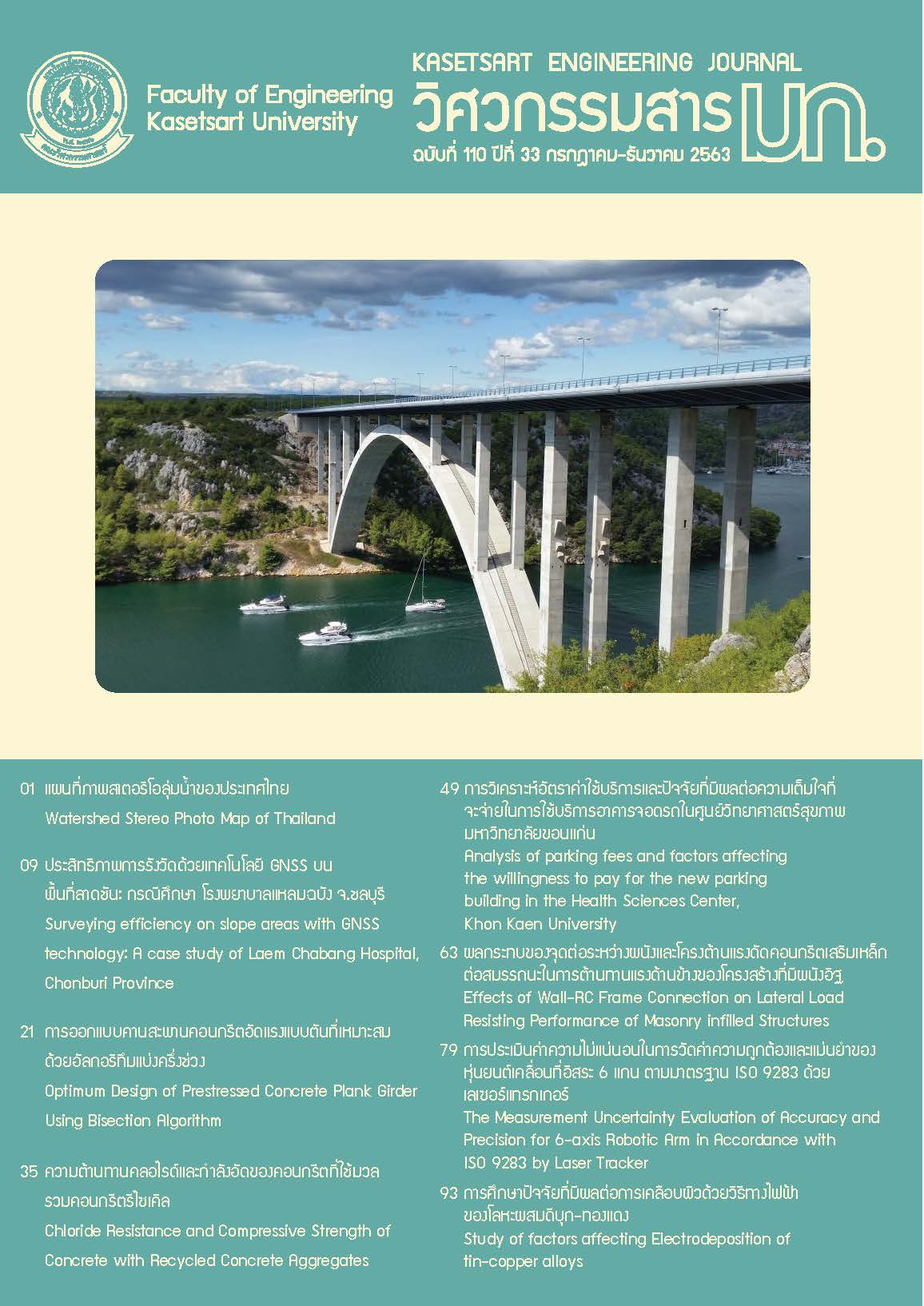Effects of Wall-RC Frame Connection on Lateral Load Resisting Performance of Masonry infilled Structures
Keywords:
Masonry wall, Construction detail, Moment frames, Cyclic load, Finite elementAbstract
In this research, the structural behavior of masonry walls under lateral in-plane loading was evaluated. The goal was to develop an effective construction detail for the wall-reinforced concrete frame connection to increase lateral load resisting performance and reduce structural damages of the seismic-resistant structures. Masonry wall structural components were tested under in-plane horizontal cyclic loads. Finite element analysis was also carried out to evaluate the structural behavior of the tested specimens and masonry infilled reinforced concrete frames. Based on the results, the load transfer capability of the wall-beam connection had a significant effect on the load resisting performance and damage level of the wall. Utilizing steel shear dowels and reinforced concrete tie beam at the wall-beam connection showed a suitable load transfer capability. Once the transferred load exceeds a certain threshold, a slip between wall and beams can occur, and consequently, reduce the wall’s damages. Applying a proposed construction detail and providing the gap between wall and columns, the lateral stiffness and strength of the structural system significantly increased, compared with those of the bare frame. Moreover, the column shear failure due to the wall-frame interaction force was eliminated.
References
Hassan A F, and Sozen M A (1997). Seismic vulnerability asssessment of low-rise buildings in regions with infrequent earthquakes. ACI Structural Journal, 94(1): 31-39.
Panagiotakos T, and Fardis M (1996). Seismic response of infilled RC frames structures. In: Proceeding of the 11th world conference on earthquake engineering. Acapulco, Mexico, Paper No 225. https://www.iitk.ac.in/nicee/wcee/article/11_225.PDF
Srechai J, and Lukkunaprasit P (2013). An innovative scheme for retrofitting masonry-infilled non-ductile reinforced concrete frames. The IES Journal Part A: Civil & Structural Engineering, 6(4): 277-289.
Wararuksajja W, Srechai J, and Leelataviwat S (2020). Seismic design of RC moment-resisting frames with concrete block infill walls considering local infill-frame interactions. Bull Earthquake Eng 18, 6445–6474. doi:10.1007/s10518-020-00942-9
Kyriakides M, and Billington S (2008). Seismic retrofit of masonry-infilled non-ductile reinforced concrete frames using sprayable ECC. In: Proceeding of the 14th World Conference on Earthquake Engineering. Beijing, China, Paper
No 05-04-0063. https://www.iitk.ac.in/nicee/wcee/article/14_05-04-0063.PDF
Billington S L, Marios A K, Blackard B, Willam K, Stavridis A, and Shing P B (2009). Evaluation of a sprayable ductile cement-based composite for the seismic retrofit of unreinforced masonry Infills. In: Proceeding of ATC and SEI conference on Improving the Seismic Performance of Existing Buildings and Other Structures. San Francisco, United States, 823-834. https://doi.org/10.1061/41084(364)75
Lukkunaprasit P, Ruangrassamee A, Boonyatee T, Chintanapakdee C, Jankaew K, Thanasisathit N, and Chandrangsu T (2016). Performance of structures in the Mw 6.1 Mae Lao earthquake in Thailand on May 5, 2014 and implications for future construction. Journal of Earthquake Engineering, 20(2): 219-242.
มยผ. 1301/1302 (2561). มาตรฐานการออกแบบอาคารต้านทานการสั่นสะเทือนของแผ่นดินไหว. กรมโยธาธิการและผังเมือง
Acun B, and Sucuoglu H (2006). Strengthening of masonry infill walls in reinforced concrete frames with wire mesh reinforcement. In: Proceeding of the 8th US National Conference on Earthquake Engineering, San Francisco, USA, Paper No 1852.
Erdem I, Akyuz U, Ersoy U, and Ozcebe G (2006). An experimental study on two different strengthening techniques for RC frames. Engineering Structures, 28(13): 1843-1851.
Altin S, Anil O, Kara E, and Kaya M (2008). An experimental study on strengthening of masonry infilled RC frames using diagonal CFRP strips. Composites Part B: Engineering, 39(4): 680-693.
Yuksel E, Ozkaynak H, Buyukozturk O, Yalcin C, Dindar A, Surmeli M, and Tastan D (2010). Performance of alternative CFRP retrofitting schemes used in infilled RC frames. Construction and Building Materials, 24(4): 596-609.
Erol G, Karadogan H, and Cili F (2012). Seismic strengthening of infilled reinforced concrete frames by CFRP. In: Proceeding of the 15th World Conference on Earthquake Engineering. Lisbon, Portugal, Paper
No 4313. https://www.iitk.ac.in/nicee/wcee/article/WCEE2012_4313.pdf
Longthong S, Panyakapo P, and Ruangrassamee A (2020). Seismic Strengthening of RC Frame and Brick Infill Panel using Ferrocement and Expanded Metal. Engineering Journal, 24(3): 45-59.
Leeanansaksiri A, Panyakapo P, and Ruangrassamee A (2018). Seismic capacity of masonry infilled RC frame strengthening with expanded metal ferrocement. Engineering Structures, 159: 110-127.
DIANA FEA BV (2019). DIANA Finite element analysis user manual. Delftechpark 19a, 2628 XJ, Delft, The Netherlands.
CEB-FIP (2010). Fib Model Code for Concrete Structures 2010. Wiley-VCH Verlag GmbH & Co. KGaA,.
American Concrete Institute (ACI) (2014). Building code requirements for structural concrete and commentary. ACI318/318R, Farmington Hills, Michigan, USA.
Lourenco P B (1996). Computational strategies for masonry structures. Ph.D. Dissertation, Universidade do Porto, Protugal.
Lourenco P B, and Rots J G (1997). Multisurface interface model for the analysis of masonry structures. Journal of Structural Engineering, 123(7): 660-668.


